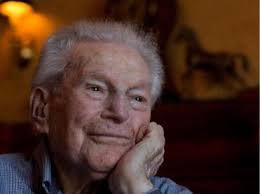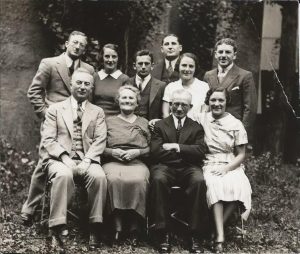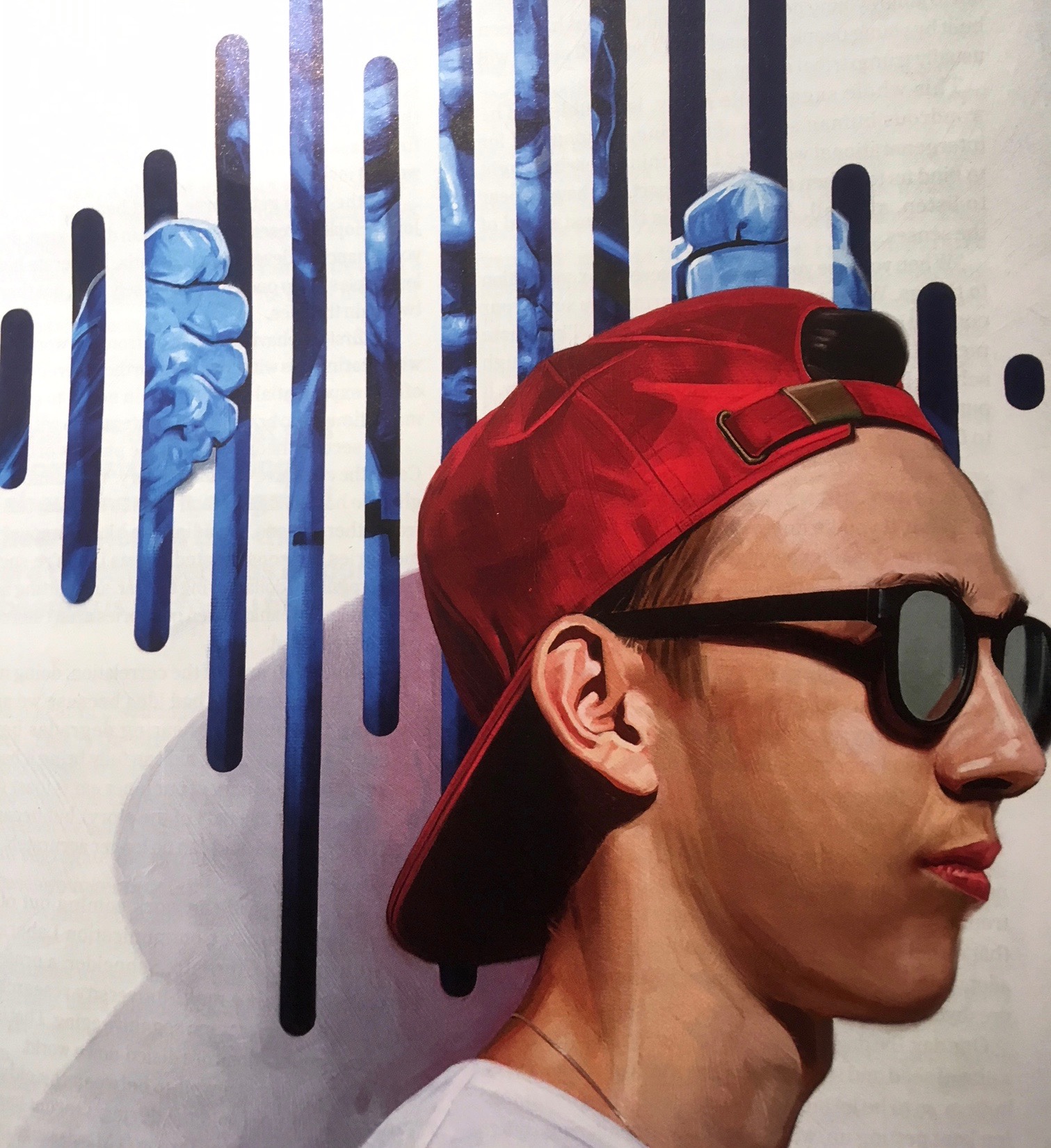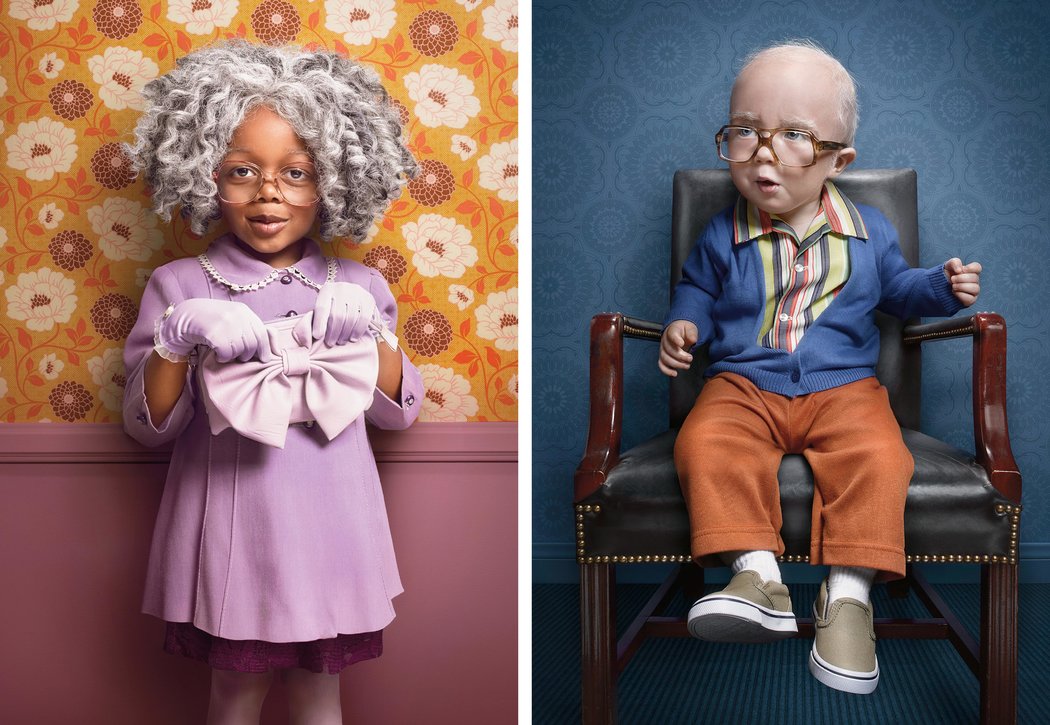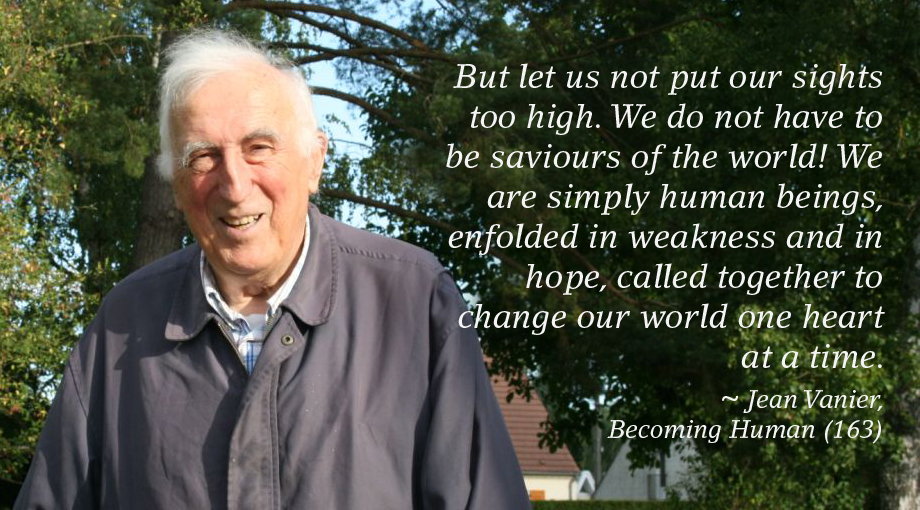from NEW TRAIL magazine, July 2018. Illustrations by Hugh Syme
In June 2015, Megan Strickfaden and her grad student Nicole Gaudet arrived at a little village on the outskirts of Amsterdam with a Harry Potter-ish name: De Hogeweyk. An octogenarian gentleman was visibly thrilled to see them.
This called for wine.
He took Strickfaden by the arm and squired her into the village grocery store, she recalls. He found a nice red and brought it to the till. He pulled a handkerchief from his pocket and paid for the wine with it. The clerk accepted the payment, bagged up the wine and gave the man back his handkerchief as change.
To its residents, De Hogeweyk — a dead-ringer simulation of a traditional Amsterdam village — isn’t a cutting-edge experiment at the frontier of humane dementia care. It is simply home. They cruise on tandem “cosy cycles” down the cobblestone streets. They munch pastries in the café, catch films at the cinema. They wander among gardens so cunningly designed as to appear limitless. They return to family-sized living spaces that closely match the tenor of the household they grew up in, whether country-cosy or artsy-cultural, full of music and light. Trained geriatric nurses and caregivers form a kind of stealth army of invisible support. They’re dressed not as authority figures but as shopkeepers, neighbours, friends, perhaps relatives.
De Hogeweyk’s reputation rests on what its residents don’t do, says Strickfaden. Based on her observations over two extended visits to the village, residents don’t fall as much or night-wander as much or take anti-psychotics nearly as much as comparable populations elsewhere.
“The place itself is medicine,” she says.
The discovery that environmental “nudges” can boost psychological well-being is one of the triumphs of the last quarter-century of social science. (One of its founders, Richard Thaler, won the Nobel Prize in 2017 for contributions to behavioural economics.) And design elements are psychological levers. By manipulating colours, furnishings, acoustics or the layout itself, architects can send the human mind back in reflection or forward in aspiration. They can slow a frightened heart or stoke curiosity or foster human connection.
Dementia is a syndrome, a deterioration in the ability to process thought beyond what might be expected from normal aging. It affects memory, thinking, language, behaviour and the ability to perform everyday activities.
Source: World Health Organization
People with dementia, it turns out, are especially good candidates for such interventions. “A person with dementia is suggestible,” Strickfaden says. “You work with that.”
Elements similar to the De Hogeweykian approach are being introduced in care facilities around the world. One of these is Canterbury Lane, the dementia wing of the Canterbury complex in west Edmonton. Strickfaden, a design anthropology professor in the Faculty of Agricultural, Life & Environmental Sciences, has been hired to consult on the multimillion-dollar revamp. It will include features such as a garden that allows residents access to the outdoors without having to be escorted. Hallways that don’t dead-end, but loop back into the heart of the action. Little designated spaces for purposeful activity, such as folding laundry. And a cottage system of living spaces divided by theme or feel, matched to the residents’ upbringings.
The renovations will take close to four years. Unfortunately, the resident in one room is unlikely to live to see it completed. That’s just my guess, knowing that resident quite well.
She is my mother.
More than 50 million people worldwide are afflicted with dementia right now. And since the human lifespan is increasing more quickly than medical science seems to be closing in on a cure (which is to say, not quickly at all), dementia will be part of all our stories: your story or the story of someone you love very much. “Its shadow lies over us all,” writes Jay Ingram in his book The End of Memory.
So what to do — beyond saying a prayer and giving power of attorney to your most trustworthy blood relative? As recently as 20 years ago, people living with dementia who could no longer manage in their homes were simply institutionalized. In that setting, doctors were authority figures and patients were the passive recipients of meds, directives — and very little in the way of treatment.
But another paradigm is emerging. Dementia treatment is coalescing around the idea of patient-centred care.
In an analysis of dementia care studies published in 2015 in the Journal of the American Geriatric Society, researcher Hannah O’Rourke, an assistant professor in the Faculty of Nursing, found four things are of central importance in working with people with dementia. A sense of place. Connection to others. A sense of purpose. And shoring up those three poles of the tent supports the fourth, which is linked to physical well-being: a sense of wellness.
So, while scientists continue their search for ways to prevent and treat the disease (See The Elusive Cure), caregivers are doubling down on tactics that promise benefits right now. Call it the “3 Ws” model of dementia care: focusing on the Where, the Who and the Why of the subjective experience of this devastating syndrome.
Our questions are everybody’s questions: what must it be like to be her? And what can we do to help make this a little more bearable — for everyone?
To family members, the hardest part to fathom about dementia is the staggering difference between Good Days and Bad Days. Good Days make you second-guess your decision to move your loved one out of their own home into extended care. Bad Days grimly confirm it.
On a recent visit, my mom positively lit up when I walked through her door. We spent a great day together, at the end of which I promised I’d be back tomorrow. Ten-kilowatt smile. But when I walked through her door the next day, she greeted me with a face that looked as if a bad fish needed taking out. “What are you doing here?” she snarled.
Mom was officially diagnosed with Alzheimer’s when she failed the “mini-mental” exam 10 years ago, at age 84. Though in truth, we noticed her slipping as early as her late 70s, one “W” after another. The “where” seemed to go first. On an Alaskan cruise, to celebrate her “80th year,” she struggled to find her way back to our cabin and had not cracked the nut even by our last day at sea.
Then the “when” became wobbly. On a visit to the West Coast, she became deeply concerned that we’d miss our flight if we didn’t leave right now. So I raced us to the airport, only to hear upon our arrival: “Why the heck are we here so early?”
Social filters fell away. Mom started making derogatory comments about people standing right next to her. She began repeating herself every 30 seconds. Sometimes she noticed herself slipping. “I feel like … I’m … not right in the head!” she’d say and she could barely contain her terror.
The changes in her reflected the brutally quixotic nature of the disease. Like a tornado through a trailer park, it destroys some faculties while leaving others bizarrely intact. On a recent visit, I told Mom it was our dog’s birthday — we were having a couple of the neighbourhood pooches over to celebrate.
“Penny,” she said, remembering the name of an animal she’d never met. “How old is she, again?”
“She’s four.”
“So, our 28,” Mom said instantly.
Sometimes my sisters and I leave the facility feeling gut-punched, yearning for the sweetness we know is in Mom to surface more often. And our questions are everybody’s questions: what must it be like to be her? And what can we do to help make this a little more bearable — for everyone?

Are We Our Memories?
Who are we without our memories? For people with dementia, recovering even some of the experience they have banked is a crucial part of feeling, well, like themselves again.
One theory of dementia-related memory loss is that it’s a retrieval issue, rather than a data-loss issue. In other words, the memories are still in there, only their tags have fallen off. In recent years, researchers have experimented with using sensory triggers to call some of those memories up.
In Scotland, aging soccer fans living with Alzheimer’s are exposed to reconstructions of big games. In North America, people with dementia are supplied with iPods loaded with personalized playlists. Out of Sweden comes an ingenious invention called the BikeAround: a stationary bicycle attached to a wrap-around movie screen onto which a moving landscape is projected. Plug in the client’s childhood-home address on Google Street View and suddenly there they are, back in the old ’hood, cruising down streets they probably haven’t since they were a kid on a Schwinn.
Reminiscence therapy, this kind of intervention is sometimes called — and preliminary research suggests it can not only boost happiness levels but improve cognitive function. This year, the Canterbury Lane staff tried a simple version of it in the run-up to Mother’s Day with a scrapbooking activity. Family members were asked to contribute photos of mom or dad through the years, surrounded, if possible, by the people they have loved the most. “You’re really trying to get them to live in those moments,” activities supervisor Mbalia Kamara told me. “And then to really validate the feelings that emerge.”
For Mom, it was pretty profound. As she turned to a snapshot of her and Dad circa 1980, both of them tanned and smiling in Hawaiian sunshine, she began to cry. A staff member allowed her to sit with that sadness for a few moments, and then steered her toward the light. “He must have been a great guy,” she said. “Tell me about your wedding day.”
The tonic here, as much as the memory work, is the attention. People with dementia often lose their voice as the disease progresses. The world stops listening. “People used to think that because there was cognitive impairment there wasn’t insight — but that’s not true,” says nursing professor and researcher Hannah O’Rourke. “People with dementia still know what they like and don’t like.” To pull that insight out is not that difficult, she says. “You ask. You just ask.”
A couple of years ago, Elly Park, a post-doctoral fellow in the U of A Faculty of Rehabilitation Medicine, undertook a project with researchers from Simon Fraser University and the University of Toronto on digital storytelling. Facilitators helped people with dementia create a digital story with photos, music and narration by the participant. “Storytelling is a tool,” writer Ursula K. Le Guin put it, “for knowing who we are and what we want.” People with dementia are no different from the rest of us in this way. Park’s research found that encouraging participants to think about and share meaningful stories enhanced relationships with caregivers, increased communication and interaction, and gave participants a sense of accomplishment. “In several cases, participants said they surprised themselves with the stories they were able to remember,” says Park.
With Mom, I have found that if I press her too much for family history, she often clams up. For her, the fact-finding is stressful. This is not uncommon. That’s why University of Wisconsin theatre professor Anne Basting received a MacArthur Fellowship, sometimes called a genius grant, for her invention called TimeSlips. It replaces “the pressure to remember with the freedom to imagine,” as she puts it. TimeSlips is like a book club where no one has read the book, except in this case it’s a photograph. Each photograph is striking and mysterious. It looks as if it has a story to tell, so everyone makes one up. There’s no way to be wrong, which seems to loosen tongues. “The absolute key to the entire process,” Basting says in a video about TimeSlips, “is that we validate everything they say.” This sounds like — it is like — improv theatre.
Something a little magical happens when we start telling stories to each other, whether they’re true or not. Neuroscience has shown that it boosts the sense of connection between the teller and the listener. As the story unspools, the brains of teller and listener sync up — a phenomenon psychologists call “linguistic alignment.” Another bonus: for people who can no longer have out-there-in-the-world adventures, storytelling is an excellent proxy. It stimulates many of the same parts of the brain that light up when we are actually experiencing things — just as reading does.
For the scrapbooking exercise at Canterbury, not all the families contributed photos. So those residents instead received pages of their scrapbooks with stock photos of a random family. Which sounds a little sad but turns out to be a perfectly serviceable alternative. “Just the idea of family can get people talking about their own,” says Kamara.
For some reason, my own earliest memories of Mom are all tagged to scents: the cinnamon-y Bee Bell Bakery, the chlorine of the Y swimming pool, the baseball-mitt smell of Jack and Jill Shoes. We’d march into these places hand-in-hand and, invariably, she’d spot someone she knew and tractor-beam them in with her smile. She’d let go of my hand — she needed both of hers to talk — and that would be it. I waited beside her as ice ages came and went. Eventually she’d track me down in some corner of the facility. I could smell her coming.
But wait: how many of these details are true? “Every act of memory is to some degree an act of imagination,” the neurologist Oliver Sacks wrote. We’re all unreliable narrators. That doesn’t mean we all have neurodegenerative disease; dementia in its various forms is a syndrome with specific physiological signatures. But it does mean that people with dementia cannot be dismissed as Other. Every time we call our kid by the dog’s name or drive off with our coffee cup on the roof, the difference between the two worlds, practically speaking, grows moot. And somewhere a busker plays There but for Fortune.
Our Purpose, Our Selves
“If the residents here were able to describe their biggest frustration, what would they say?” I asked Wendy King, executive director of the Canterbury Foundation, not long ago. “I think maybe they would say, ‘You don’t understand me,’ ” she replied.
Hence, a recent trend in dementia care toward what you might call deep client profiling. In the old days, staff received an incoming resident’s medical charts, some basic biographical data and not much else. Now, families are often asked to flesh out the story of mom or dad. The more data, the greater the likelihood a resident ends up where they belong, doing things that pluck the strings of their hidden enthusiasms.
A “sense of purpose,” as O’Rourke discovered in her analysis of dementia studies, can involve many things: the feeling of contributing to others; a belief in a higher power; some control over how your day unfolds. From a caregiver’s perspective, restoring a sense of purpose is about reconnecting people with who they used to be — placing them back in the vicinity of that intersection where, as American writer and theologian Frederick Buechner put it, their deep desire meets the world’s deep need.
Strickfaden recalls one man at De Hogeweyk who was restless and searching, and a bit aggressive and hard to approach. Staff went back into his file and discovered he’d once been a farmer. “So one day they hid a bunch of eggs all around the courtyard. And they said, ‘We need you to go collect the eggs in the morning.’ And he’d do that. And then he’d be wonderful for the rest of the day. It was something that validated who he was.”
Alzheimer’s disease is the most common cause of dementia, accounting for about 60 to 70 per cent of cases. Dementia can also be caused by stroke, injury or other diseases.
Source: World Health Organization
At Canterbury, one resident used to be a millwright, so he’s routinely given things to tinker with. Another was a homemaker who raised a big family. She struggles to find words and can get frustrated and withdrawn, but she positively melts when handed lifelike “Baby Sophia.” She dresses the doll in tiny clothes warm from the dryer, whispering and cooing to her and, after a while, “she’s more open to the activities the rest of us are doing,” says Kamara.
But there’s purpose and then there is purpose — something closer to what the Japanese call ikigai. Roughly: the sense that life is worth living because we are needed here. Japanese research has found that people with ikigai live longer. A study published in JAMA Psychiatry in 2012 found that people with Alzheimer’s who are animated by purpose staved off cognitive decline longer. No one knows quite why it matters to feel as if we matter — only that it does.
“Feeling you matter is at the core of being a person,” British dementia consultant David Sheard often says. “Knowing you matter is at the heart of being alive.” Sheard is the founder of Dementia Care Matters, better known as the “butterfly” model of dementia care. I could see its principles in action the day I visited Copper Sky Lodge, in Spruce Grove, Alta., Canada’s first butterfly facility. Copper Sky’s CEO is Phil Gaudet, well-known in Alberta as the former head of the Good Samaritan Society, a long-running non-profit care provider. But the lodge is mostly run these days by his daughter, Nicole Gaudet. The same Gaudet who, with her thesis advisor Strickfaden, was embedded at De Hogeweyk.
As dementia advances and individuals turn inward, they’re less able to seek out the multi-sensory stimulation they may need. So the stimulation must come to them — as butterflies come to flowers. “Even things like this soft sweater I have on are part of it,” Gaudet says of the fuzzy sweater she’s wearing. “I’ve been getting lots of hugs today.”
At the centre of the butterfly model is emotion. The theory: people will forget what you say, and even what you do, but they will never forget how you made them feel. That’s because feeling is processed in a more primitive part of the brain; it’s protected, in a sense, from the damage to the neocortex that dementia causes. And so the staff at Copper Sky are trained to circulate, alighting here and there, touching, affirming, offering a cup of tea or a taste of mint, introducing short activities. “Ultimately, we are all feeling beings,” says Gaudet. “So if you can connect to what somebody is already feeling, you’re four steps ahead.”
But there’s research and then there’s practice. Changing how we care for people with dementia isn’t easy. After their experience at De Hogeweyk, Strickfaden and Gaudet were gung-ho to update legislation around dementia care in Canada. They soon discovered they were facing frustrating headwinds, some of which were cultural.
A country’s dementia care can reveal a lot about its values. China, for instance, is a culture of service, notes Strickfaden. “But that can actually get in the way of good elder care. People are literally served to death.” The Netherlands is big on personal liberties. How far you want to push your limits is up to you, within reason. Quality of life reigns supreme.
Canada has made a different choice. Here a dementia-care facility gets accredited or not based in part on how safe it’s deemed to be, says King, head of Edmonton’s Canterbury Lane. So De Hogewykian elements like cobblestones, public fountains, accessible barbecues and knives, unfenced kitchens are red flags. In Canada, safety trumps freedom. So does efficiency. Funding here is task-based. “Staff have a task list and a limited amount of time to do it,” says King. “So if a resident puts up resistance, it creates stress — because the staff person knows, ‘I’ve got to go to Mrs. Jones next.’ ”
The task-based funding model is, predictably, frustrating for more progressive voices in dementia care. “You’re regulating to the point of strangulation,” says Gaudet.
After Copper Sky received a poor grade in its first effort to become a certified butterfly facility three years ago, Gaudet spearheaded massive staff retraining. The first thing she impressed on caregivers is that human connection comes first. You are not going to be fired if you don’t get this task and this task and this task done, she told staff. Even though by some measures the extra TLC means more work for them, there’s evidence that such an approach leads to lower burnout, since it puts caretakers’ actions more in line with the reasons they got into this work in the first place.
“I would abolish long-term care in Canada and start over,” says Gaudet, “because I think we’ve got it wrong. We need to be given the freedom to deliver new kinds of care in inspiring environments.”
O’Rourke is cautiously optimistic about the future of dementia care in Canada. “If we — clinicians, researchers, community members, society — can set aside our own fears, assumptions and stigmas about the disease, there is hope. People with dementia have identified many ways to achieve a good quality of life. We just need to listen.”
one recent wednesday afternoon at Canterbury Lane, residents sat drowsing in easy chairs in front of an old Jimmy Stewart movie on the big-screen TV. My mother wasn’t among them. She likes the privacy of her room and to pick her own shows — and to crank up the volume.
On this visit, I had a plan. Having steeped myself in the Alzheimer’s literature and the best ideas of countless experts in multiple domains, I was eager to try a few things. I wanted to help Mom grasp where she is, who she is and why she is. I’d brought an artifact: a tennis racket. Not one of the fancy big ones people wield now but a vintage wooden one. This is what you used in the era when Mom learned to play, gliding around the shale courts of Garneau tennis club, not long after she and my dad met. People can see it on the wall and ask Mom about tennis. And maybe some of those locked-up memories — a serve tossed into the sun, the fitz of a new tin of balls, my dad so gentlemanly out there that he actually cheated against himself — will come rushing back.
Not long ago my sister Lynn noticed Mom paging through a magazine that had a big splash about the Royal Family. Mom pointed to a gentleman in a waistcoat. “That is the man I’m going to marry,” she said. A few years ago Lynn might have laughed or corrected her. But we have learned that it’s not our job to pull Mom back into this world. Our job is to meet her in hers. Lynn raised her eyebrows in enthusiasm, nodded and asked for details about the wedding.
These days Mom’s eyes reveal a lot. There’s not much reminiscing going on. Nor is there planning. The headlights reach to the next bend in the road and that’s it. But this is what people with dementia have, most profoundly, to teach us. They are champions at living in the now. The question, for all of us, is how can we make the now better?
I believe the answer is to just be there. Or in the case of my own too-infrequent visits, make sure I’m therewhen I’m there.
So Mom and I go for silent wheelchair tours to check out the action over in the nearby manor — past the kitchen, down the long, carpeted hallways. Little bios outside each resident’s door tell of their unique strengths. That’s right out of the David Sheard playbook: “Search for the treasure in each individual.”
“I’ve learned that if I attach too much to whether she remembers my visit, I’m going to be bitter,” Lynn told me on the phone recently. So you shift the bar. A cup of coffee, a stab at a cribbage game, a trip to the atrium to hear the piano player plink out Moon River: that is a win. We are not our memories.
Even though it sometimes feels that way.






